
Lakeland is a city in Polk County, Florida, along Interstate 4 east of Tampa. The westernmost city in Polk County, it is part of the Tampa Bay Area. According to the 2018 U.S. Census Bureau estimate, the city had a population of 110,516. Lakeland is a principal city of the Lakeland–Winter Haven Metropolitan Statistical Area.
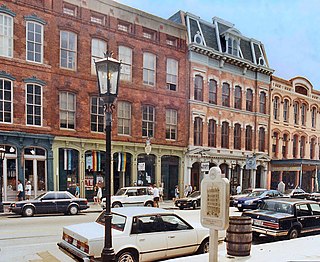
The Strand Historic District, also known as the Strand District, in downtown Galveston, Texas (USA), is a National Historic Landmark District of mainly Victorian era buildings that now house restaurants, antique stores, and curio shops. The area is a major tourist attraction for the island city and also plays host to two very popular seasonal festivals. It is widely considered the island's shopping and entertainment center. The district includes properties along the south side of Harborside Drive and both sides of The Strand and Mechanic Street from 20th Street westward to 26th Street.

Overbrook is a neighborhood northwest of West Philadelphia, Philadelphia, in the U.S. state of Pennsylvania. The area's housing ranges from large, old homes to rowhouses to 3- and 4-story apartment buildings.

The Jefferson Market Branch of the New York Public Library, once known as the Jefferson Market Courthouse, is a National Historic Landmark located at 425 Avenue of the Americas, on the southwest corner of West 10th Street, in Greenwich Village, Manhattan, New York City, on a triangular plot formed by Greenwich Avenue and West 10th Street. It was originally built as the Third Judicial District Courthouse from 1874 to 1877, and was designed by architect Frederick Clarke Withers of the firm of Vaux and Withers.

Overbrook Farms is a neighborhood on the western edge of the West Philadelphia section of Philadelphia, Pennsylvania, United States. It is roughly bounded by City Avenue, 58th Street, Woodbine Avenue, and 66th Street at Morris Park. The neighborhood is bisected by Lancaster Avenue and the original Pennsylvania Railroad "main line". Today the rail line is used by both Amtrak passenger service and SEPTA's commuter Paoli/Thorndale Line.
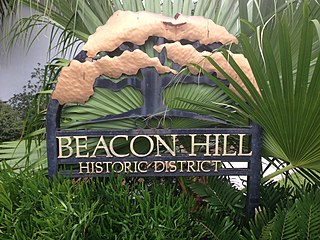
The Beacon Hill-Alta Vista Residential District is a U.S. historic district located in Lakeland, Florida. The district is bounded by South Florida Avenue, West Beacon Road, West Belvedere Street and Cherokee Trail. It contains 77 historic buildings.
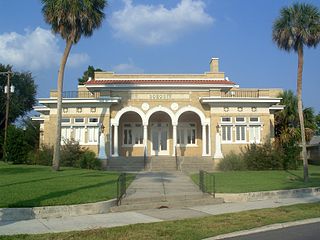
The East Lake Morton Residential District is a U.S. historic district located in Lakeland, Florida. The district is bounded by Orange Street, Ingraham Avenue, Palmetto Street, Lake Morton Drive and Massachusetts Avenue. It contains 215 historic buildings.

The Lake Hunter Terrace Historic District is a U.S. historic district located in Lakeland, Florida. The district is bounded by roughly Central Avenue, Greenwood Street, Ruby Street, and Sikes Boulevard. It contains 163 historic buildings.

The Munn Park Historic District is a U.S. historic district located in Lakeland, Florida. It is named in honor of the city's founder, Abraham Munn. The district is bounded by East Bay Street, North Florida Avenue, East Orange Street, and East Main Street. It contains 48 historic buildings and 1 object.

The Kenwood Historic District is a U.S. historic district located in St. Petersburg, Florida. The district was designated on August 4, 2003 and is located immediately west of downtown, bounded by 9th Avenue North, 1st Avenue North, 19th Street North and 34th Street North. It contains 2,203 historic buildings, and Grand Central adjoins the district at its southern boundary.

Indiana Avenue is a historic area in downtown and is one of seven designated cultural districts in Indianapolis, Indiana. Indiana Avenue was, during its glory days, an African American cultural center of the area. The Indiana Avenue Historic District within the area was designated a United States national historic district in 1987.

Tampa Union Station (TUS) is a historic train station in Tampa, Florida. It was designed by Joseph F. Leitner and was opened on May 15, 1912, by the Tampa Union Station Company. Its original purpose was to combine passenger operations for the Atlantic Coast Line, the Seaboard Air Line and the Tampa Northern Railroad at a single site. The station is located at 601 North Nebraska Avenue.

Henley Field is a historic site in Lakeland, Florida. Built in 1922, it is located at 1125 North Florida Avenue. Clare Henley, for whom the park was named in 1942, encouraged its construction in an effort to persuade a professional baseball team to train there. On May 23, 1997, it was added to the U.S. National Register of Historic Places.

The Leather District is a neighborhood of Boston near South Street, between the Financial District and Chinatown. The Leather District is a tightly defined area bounded by Kneeland Street to the south, Essex Street to the north, Atlantic Avenue to the east and Lincoln Street to the west. It is so named due to the dominance of the leather industry in the late 19th century.

The Lummus Park Historic District or simply Lummus Park, is on the National Register of Historic Places and a locally historic designated district in Miami, Florida. It is roughly bound by Northwest Fifth Street to the north, Flagler Street to the south, Northwest Third Avenue to the east, and the Miami River to the west. On October 25, 2006, it was added to the U.S. National Register of Historic Places. Lummus Park has some of the oldest structures in Miami, and over the decades, has been able to retain a large part of its early pioneer character.
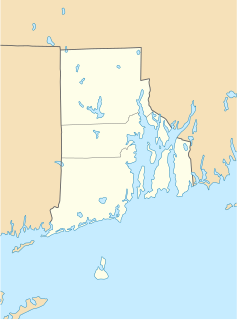
Elmwood is a neighborhood in the South Side of Providence, Rhode Island. The triangular region is demarcated by Broad Street, Elmwood Avenue, and Interstate 95.

Child of the Sun, also known as the Florida Southern College Architectural District, is a group of buildings designed for the campus of the Florida Southern College in Lakeland, Florida, United States, by American architect Frank Lloyd Wright from 1941 through 1958. The buildings are listed on the National Register of Historic Places, and together form the largest collection of buildings by the architect. It was designated a National Historic Landmark on March 2, 2012. On April 18, 2012, the AIA's Florida Chapter ranked it eighth on its list of Florida Architecture: 100 Years. 100 Places.
The New Jersey Register of Historic Places is the official list of historic resources of local, state, and national interest in the U.S. state of New Jersey. The program is administered by the New Jersey's state historic preservation office within the New Jersey Department of Environmental Protection.

The Kay Street–Catherine Street–Old Beach Road Historic District is a historic district in Newport, Rhode Island. The area is located north of Newport's well-known Bellevue Avenue, and encompasses an area that was developed residentially between about 1830 and 1890, for the most part before the Gilded Age mansions were built further south. The district is bounded on the south by Memorial Boulevard, on the east by Easton's Pond, on the west by Bellevue Avenue and Kay and Bull Streets, and on the north by Broadway, Rhode Island Avenue, Prairie Avenue, and Champlin Street. The district was added to the National Register of Historic Places on May 22, 1973, with a boundary decrease in 2018.
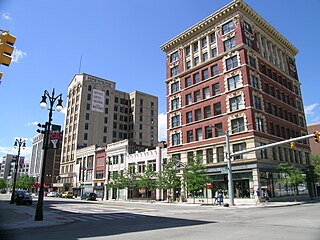
The Broadway Avenue Historic District is a historic district located on a single city block along Broadway Avenue between Gratiot and East Grand River in downtown Detroit, Michigan. It was listed on the National Register of Historic Places in 2004. The Broadway Avenue Historic District joins the Randolph Street Commercial Buildings Historic District, a rare surviving commercial area which dates from the 1840s.



















